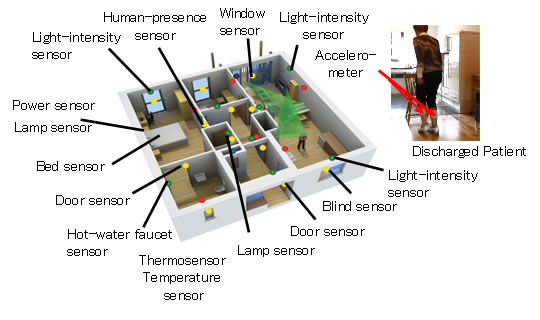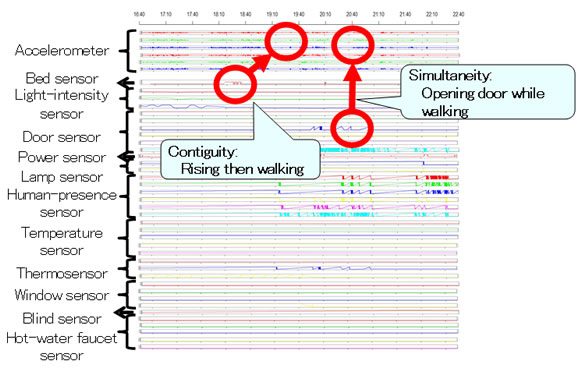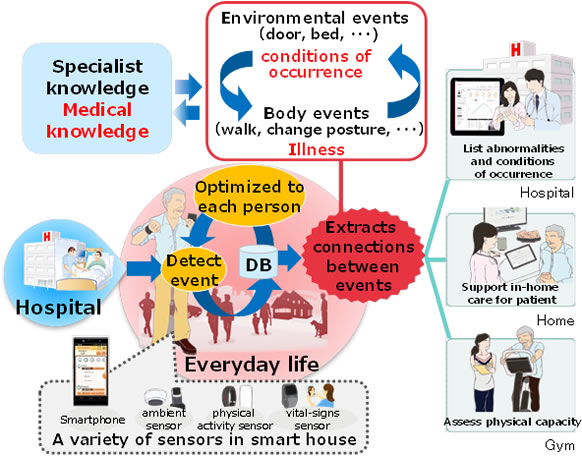Archived content
NOTE: this is an archived page and the content is likely to be out of date.
Fujitsu Develops Technology for early detection of irregularities in motor functions using a sensory smart house
Identifies risks from the relationships between daily routines and illnesses to support independent lifestyles
Fujitsu Laboratories Ltd.,Fujitsu Ireland Ltd.,Fujitsu Limited
-
[1] CASALA
Centre for Effective Solutions for Ambient Living Awareness. Built and operates the Great Northern Haven trial smart house equipped with environmental sensing in Dunkirk, Ireland. Works with residents to monitor activities and prototype devices, and conducts trials of service offerings.
-
[2] Insight@UCD
Insight Centre for Data Analytics at University College Dublin. As part of the wider Insight Centre for Data Analytics, the Personal Sensing research group in Insight@UCD brings together expertise from life and clinical sciences, and biomedical engineering to enhance the application of the sensor web to challenges in connected health. Insight@UCD's fundamental research activities relate to a connected ecosystem which is dependent on an efficient and unobtrusive approach to sensing, sharing and analyzing data to facilitate timely delivery of accurate information to all stakeholders in the process whether dealing with chronic disease or performance enhancement.
-
[3] Research project to support independent living
See “Fujitsu Launches Research Project to Provide Health Monitoring Technologies and Assisted Independent Living for Smart House Residents in Ireland” (June 28, 2013 press release).
About Fujitsu
Fujitsu is the leading Japanese information and communication technology (ICT) company offering a full range of technology products, solutions and services. Approximately 162,000 Fujitsu people support customers in more than 100 countries. We use our experience and the power of ICT to shape the future of society with our customers. Fujitsu Limited (TSE: 6702) reported consolidated revenues of 4.8 trillion yen (US$46 billion) for the fiscal year ended March 31, 2014. For more information, please see http://www.fujitsu.com.
About Fujitsu Laboratories
Founded in 1968 as a wholly owned subsidiary of Fujitsu Limited, Fujitsu Laboratories Ltd. is one of the premier research centers in the world. With a global network of laboratories in Japan, China, the United States and Europe, the organization conducts a wide range of basic and applied research in the areas of Next-generation Services, Computer Servers, Networks, Electronic Devices and Advanced Materials. For more information, please see: http://www.fujitsu.com/jp/group/labs/en/.
About Fujitsu Ireland
Fujitsu is the world's third-largest IT solutions provider and among the top five IT solutions provider in Ireland. Employing 350 staff in Ireland, Fujitsu defines, designs, builds and operates innovative IT solutions, products and services, helping our customers to realise the benefits of the connected economy. In Ireland we offer a full portfolio of IT products, solutions and services. We concentrate on our core strengths, delivering customer focused IT applications, infrastructure development and management and outsourcing across end user, networking and data centre environments. These are supported by a full range of related services, from management and technology consulting, through to integration and deployment.
We work with our customers to identify potential opportunities for technological change such as virtualisation in their industry. We then develop and deliver on an action plan to capitalise on these to their commercial advantage. Led by CEO, Regina Moran, the company attributes its success to its Japanese heritage of Lean computing and a methodology based on the concept of continuous service improvement combined with a focus on good technology.
Fujitsu's existing customer base includes some of the leading organisations in the public and private sectors in Ireland including Telefónica Ireland Ltd, Office of the Revenue Commissioners, Office of the Houses of the Oireachtas, Department of Transport, SSE Renewables Holdings Ltd, Dublin City Council, Bord Gais - Networks (and Irish Water), TEAGASC, Electricity Supply Board, Susquehanna, Topaz Energy Limited, Road Safety Authority, IADT, Department of Defence (including Defence Forces Ireland), Aviareto Limited, Doosan Trading Ltd, Dalkia, Department of Social Protection, University College Dublin, Ordnance Survey Ireland, New Ireland Assurance Plc, Department of Enterprise Trade and Employment, Health Protection Surveillance Centre, Irish Blood Transfusion Service, KBC Bank Ireland Plc, Bord na Mona.
Press Contacts
Marketing and PR Division
![]() E-mail: marketing@ie.fujitsu.com
E-mail: marketing@ie.fujitsu.com
Company:Fujitsu Ireland Ltd.
Technical Contacts
Human Centric Computing Laboratories
Human Solutions Lab.
![]() E-mail: kiduku-press2015@ml.labs.fujitsu.com
E-mail: kiduku-press2015@ml.labs.fujitsu.com
Company:Fujitsu Laboratories Ltd.
All company or product names mentioned herein are trademarks or registered trademarks of their respective owners. Information provided in this press release is accurate at time of publication and is subject to change without advance notice.
Date: 10 March, 2015
City: Kawasaki and Tokyo, Japan, and Dublin, Ireland
Company:
Fujitsu Laboratories Ltd. / Fujitsu Ireland Ltd. / Fujitsu Limited


